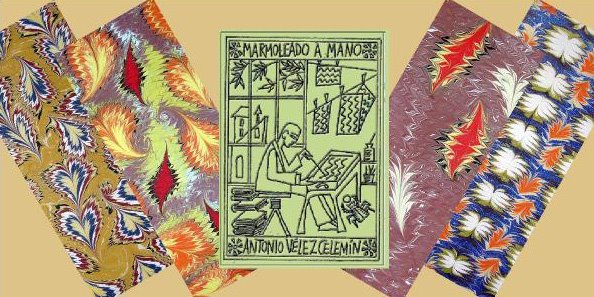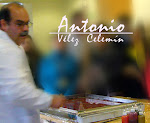It is said that the Suminagashi,
the Japanese technique of the “floating ink”,
is the origin of marbling.
Truly, only the Suminagashi presents examples
dated almost a thousand years ago.
In fact, on 1118 is dated the most ancient paper that survives realized with this technique,
but the origins of the Suminagashi should have been much more ancient.
It is a technique that doesn’t need many materials for its achievement.
Little more is needed than plain water, calligraphy ink and a special liquid, the resin of the
Paulonia imperialis, an endemic tree of Japan, which was traditionally used,
although in Occident it is possible to replace it with Photo-flow, a Kodak surfactant.

filling completely the tray of concentric rings.

Later, with a fan to produce air,
or with small blows moving the tray,
these rings turn into broken lines..
done by hand and, therefore, irregular,
absorbs the painting in that way,
darker here, there clearer,
contributing this way, just as the air or the movement....

When this technique traveled to the Asian continent,
it appeared in Persia already transformed into marbling.
A thickener had been added to the water,
the tragacanth gum,
extracted from the scales of the Dragon tree;
and natural pigments of diverse colors were used,
in contrast with the Suminagashi, which used black ink at first,
Suminagashi = black ink that floats,
and only blue and red inks were added,
Ainagashi and Beninagashi,
after long time.
I have not been able to show all these models here,
but with the marbling technique I have realized an evocation of the Suminagashi,
a false Suminagashi,
with black, blue and red watercolors,
with water thickened with Irish moss
and crossing the rings with a needle.
With black watercolor.......

blue one...

and red.

Mixing blue and black...

red and black...

or with the three of them together.

I used also my own methods
to make some different compositions,
like "stars"......

or like this flower...
 But if Suminagashi is the origin of marbling,
But if Suminagashi is the origin of marbling,how did the Suminagashi appears?
The doctor Richard J. Wolfe, the author of a monumental work on marbling...
The teacher Richard J. Wolfe, author of a monumental work on the marmoleado...(Marbled Paper: Its History, Techniques and Patterns. Philadelphia: University of Pennsylvania Press, 1990)
suggests that a calligrapher, on having washed his pen waving it in a bucket full of water and remains of ink,
should realized the drawing that was formed in that surface,
and he has the idea of retaining it in a paper.
But this is not the only version of how the invention could happen.
The Hiroba family, in possesion for four hundred years of the privilege of manufacture of these papers for the Imperial Court,
made circulate the legend of one of his members,
Jiyemon Hiroba, who received the secret of the manufacture of the Suminagashi
directly from the god Kasuga, on February 1, 1151,
in the Nara temple...
... probably this is an interested version.
The real truth is that the Suminagashi belongs to all the living beings.
It is a gift that we all must share.
It is made with natural elements, water and resin,
and with the intermediation of the wind or the movement.
The master only intervenes assembling these elementary forces and,
perhaps, with the knowledge of his experience,
he decides when it must stop.
I discovered this truth some time ago,
when Ingrid Weimann sent to me this photo of Jim Anderson,
entitled: "the Sumi master",
my thanks to both.

PS:
I'm linking here the page of the artist Beatriz Mahan
On News, search for Suminagashi workshop,
you will find beautiful photos and an interesting PDF with
more instruccions (in Spanish, I'm sorry).






































